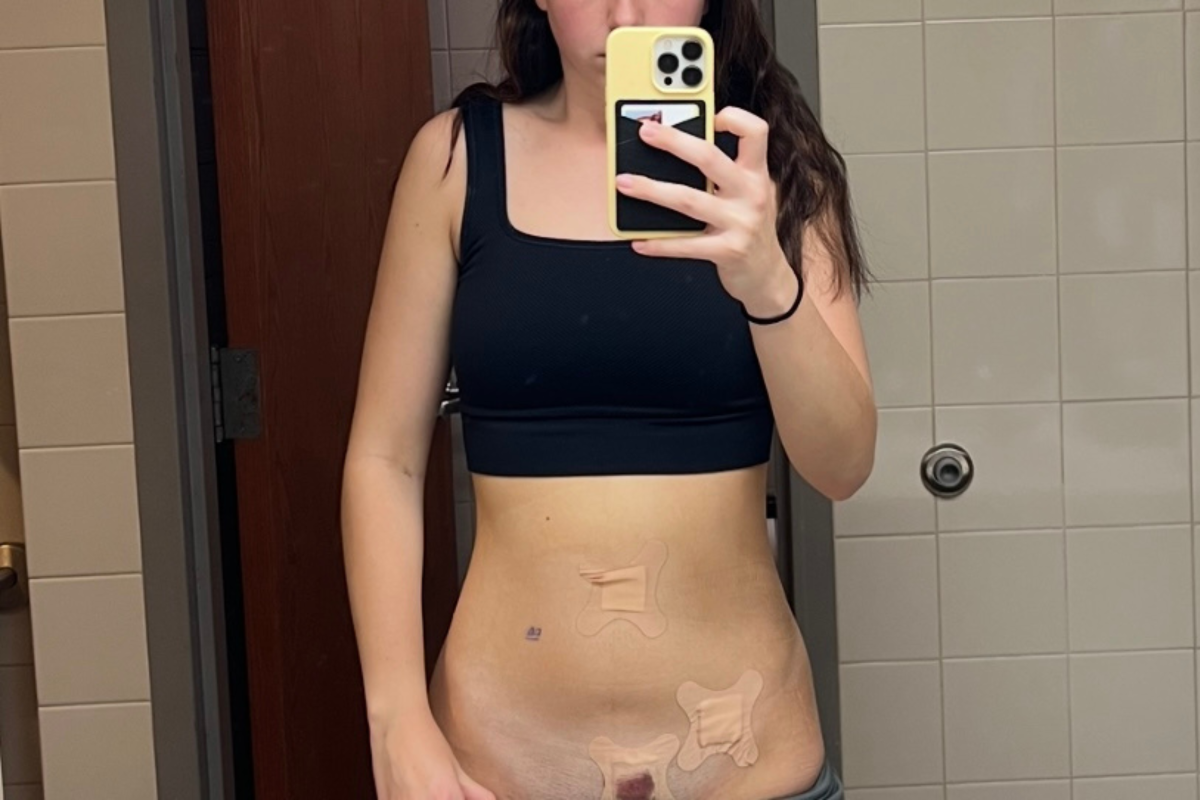
After months of pain, a 20-year-old from Illinois was diagnosed with a cyst on her ovary—but it was far from ordinary, as the mass was like something straight out of a science fiction movie with teeth and hair.
The problems started in March 2023 when Savannah Stuthers got a copper IUD inserted at the age of 18. She told Newsweek that she felt “an immense amount of pain” during the procedure but was reassured that everything looked fine.
Stuthers experienced heavy bleeding and painful cramping for a few weeks, but after calling her doctor, she was told it just “takes a while to get adjusted.” Unfortunately, the symptoms continued to get worse in the months that followed.
“By July, the same light bleeding was continuing with cramps more frequently. At this point, I was just going on with my life, accepting that I was supposed to bleed every day and have this constant pain,” Stuthers said.

Savannah Stuthers / @savcaroline.spam
By September 2023, she’d relocated for school and remembers texting her mom to say she had terrible cramps that she could feel “all the way up to [her] heart.”
But Stuthers, who now resides in Fayetteville, Arkansas, as she pursues as major in finance at the University of Arkansas, ignored the pain as she’d been “constantly invalidated by doctors.”
“By October, I had this horrible gut-wrenching pressure pain in my lower abdomen that made simple tasks like walking feel impossible,” Stuthers said. “After recognizing this, the light bleeding turned into very scary, large amounts of bleeding. This was the point where I realized something was wrong and took myself to the ER.”
An ultrasound at the hospital revealed an 8×7 centimeter cyst on her left ovary.
After this shock revelation, Stuthers was referred to an OBGYN a week told Stuthers he was “deeply concerned” by the size of the cyst. As a result, he wanted to schedule a laparoscopic surgery that same week.
Laparoscopic surgery is a technique used to examine abdominal and pelvic organs by making small incisions.
The OBGYN planned to remove the cyst laparoscopically, but this didn’t prove possible. He told Stuthers that it was “the size of his fist,” and he needed to make a cesarean-section incision instead.
When they finally opened the cyst, there was complete shock at what they discovered.
“Once he got to the cyst, my ovary was no longer attached, and blood flow was completely cut off. They opened the cyst and saw hair, teeth, fat, and something that looked like an eyeball (after sending it for testing, they found out it was not actually an eyeball),” Stuthers told Newsweek.

Savannah Stuthers / @savcaroline.spam
The cyst was in fact a teratoma, which is a rare type of germ cell tumor that can contain immature or fully formed tissue. As explained by the Cleveland Clinic, germ cells are the only cells which can turn into other types of cells, meaning teratomas can contain fragments of any other body part.
Teratomas commonly include teeth, hair, fat, and muscle, but less common possibilities include liver, lungs, brain, and thyroid gland. They can be cancerous, but most teratomas are benign. Nonetheless, they need to be removed to prevent them from growing or rupturing.
Learning that she had a cyst seemed bad enough, but nothing could have prepared Stuthers for the moment she learned it was a teratoma with teeth and hair. She told Newsweek that she “nearly vomited” when she was shown pictures.
The teratoma was removed in its entirety, by which point it had grown to a 10×10 centimeter mass. Unfortunately, doctors also had to remove Stuthers’ left ovary.
“I had millions of questions, but the most important question was whether I would still be able to have kids. I was so young to lose an ovary. The doctor seemed on the verge of tears telling my mom and I the cyst grew so big that it twisted and killed my ovary,” Stuthers said.

Savannah Stuthers / @savcaroline.spam
Stuthers was reassured that her right ovary is still healthy and shouldn’t affect her ability to start a family.
While she was relieved to know the teratoma had been removed, Stuthers felt horrified by the thought of what had been growing without knowing.
“It messed me up for a while thinking about how I never knew that it was there. In a way, it made me feel gross. The photo of the tumor truly altered my brain chemistry,” Stuthers said.
The Social Media Reaction
In April 2025, Stuthers shared her experience on TikTok (@savcaroline.spam), unaware that her story would cause shockwaves online. A photo showing her horror when she woke up from surgery has gone viral with over 33.7 million views and 3.3 million likes on TikTok at the time of writing.
The response is beyond anything the 20-year-old student imagined, but she hopes to educate others and raise awareness.
“I hadn’t even heard of a teratoma until I woke up from the surgery. I feel like it should be a more commonly known thing, especially with how many people commented saying the same thing happened to them,” Stuthers told Newsweek.
She said: “I got lucky as we found it in time so nothing too extreme happened. But I can’t help but think that if my doctors in Illinois would’ve listened, I would still have both ovaries. It is so important for women to express our pain and not allow doctors to invalidate us.”
Is there a health issue that’s worrying you? Let us know via health@newsweek.com. We can ask experts for advice, and your story could be featured on Newsweek.




